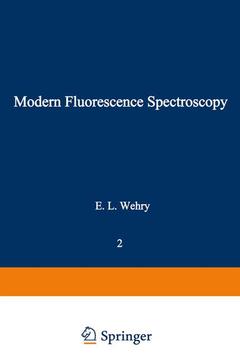Description
Modern Fluorescence Spectroscopy, Softcover reprint of the original 1st ed. 1976
Modern Analytical Chemistry Series
Coordinator: Wehry Earl
Language: English
Subjects for Modern Fluorescence Spectroscopy:
Publication date: 10-2012
460 p. · 15.2x22.9 cm · Paperback
460 p. · 15.2x22.9 cm · Paperback
Description
/li>Contents
/li>
The principles of fluorescence spectroscopy are by now well established, and, after a rather lengthy gestation period, the technique is now routinely applied to a broad spectrum of problems, ranging from mechanistic photo chemistry to chemical analyses in biomedical and environmental systems to probes of structure and function in biological macromolecules. Phosphor escence spectrometry and chemiluminescence are also well-known tech niques; they are somewhat less well established than fluorescence (at least in analytical chemistry), but they too are receiving greatly increased appli cation to both laboratory and "real" problems. This is not to imply that luminescence spectroscopy, viewed in its broadest sense, is a static field. In fact, recent advances in instrumentation make it feasible to apply fluorescence to problem areas in which its use five years ago would have been unthinkable. Advances in hardware generate advances in application, and very significant progress is being recorded in the application of fluorescence (and its close relatives, phosphorescence and chemiluminescence) in the biochemical, biomedical, and environmental spheres.
of Volume 2.- 1 Applications of Centrifugal Fast Analyzers to Fluorescence and Chemiluminescence Analyses.- A. The Centrifugal Fast Analyzer: A New Concept in Automated Analytical Instrumentation.- B. Basic Components and Principles of Operation of Centrifugal Fast Analyzers.- C. Optimization of the Centrifugal Fast Analyzer Optical System for Fluorescence Measurements.- D. Dynamic Fluorescence Referencing for Direct Calculation of Concentration and Enzyme Activity Units from Intensity Data.- E. Applications of the Centrifugal Fast Analyzer to Fluorescence, Light-Scattering, and Chemiluminescence Measurements.- F. Summary and Conclusions.- References.- 2 Applications of Luminescence Spectroscopy to Quantitative Analyses in Clinical and Biological Samples.- A. Introduction.- B. General Requirements of Clinical and Biological Analyses.- C. Methods of Clinical Fluorometry.- D. Modern Methods of Fluorescence Detection.- E. Automated Analysis.- F. Chemiluminescence and Bioluminescence.- G. The Future of Fluorometry in Clinical and Biological Analysis.- References.- 3 Fluorescent Probing of Dynamic and Molecular Organization of Biological Membranes.- A. Introduction.- B. Theory and Practice.- C. Applications to Model Membrane Systems.- D. Applications to Biological Membranes.- E. Concluding Discussion.- F. Addendum.- References.- 4 The Application of Fluorescence Techniques to the Study of Micellar Systems.- A. Introduction.- B. Experimental Techniques Used in Fluorescent Probing of Micelles.- C. Measurement of the Time Dependence of Fluorescence.- D. Theory of Fluorescence Quenching Processes in Micellar Systems.- E. Dynamics of Pyrene Fluorescence in Solutions of Simple Detergent Micelles.- F. Influence of Additives upon the Permeability of Sodium Lauryl Sulfate Micelles.-G. Pyrene Fluorescence in Aqueous CTAB Micelles. Dynamics of Motion of Solubilized Pyrene Molecules.- H. Fluorescent Probing of Specific Regions of Micelles.- I. Individual and Specific Micelles.- J. Fluorescence Studies of Phase Transistors in Micellar Systems.- K. Fluorescence Studies of Inverted Micelles.- References.- 5 Fluorescent Probe Studies of Binding Sites in Proteins and Enzymes.- A. Introduction.- B. Fluorescence of Pyridoxamine-5-P.- C. Binding of 4-Pyridoxic-5?-P to Ribonuclease A.- D. Fluorescence Indicators of Enzyme-Enzyme Interactions.- E. Energy Transfer in Pyridoxyl-5-P Protein Complexes.- References.- 6 Acid-Base Chemistry of Excited Singlet States: Fundamentals and Analytical Implications.- A. Introduction.- B. Chemical Structure and the Acid—Base Properties of the Ground and Lowest Excited Singlet States.- C. Dynamic Aspects of Proton Exchange in the Lowest Excited Singlet State.- D. Prediction of Excited-State Proton Exchange.- References.- 7 Use of Fluorescence to Study Structural Changes and Solvation Phenomena in Electronically Excited Molecules.- A. Introduction.- B. The Franck-Condon Principle.- C. Nuclear Conformation and Spectroscopic Behavior for Ring and Ring-Chain Systems.- D. Examples of Spectroscopic Studies on Ring Systems.- E. Examples of Spectroscopic Studies on Ring-Chain Systems.- F. Polar Substituent Rotations in the Excited State.- G. Studies on Solvation of the Excited State.- H. Conclusion.- References.- 8 The Study of Excited State Complexes (“Exciplexes”) by Fluorescence Spectroscopy.- A. Introduction.- B. On the “Charge-Transfer” Nature of Singlet Exciplexes.- C. The Formation of Exciplexes.- D. The Decay of Exciplexes.- E. Triplet Exciplexes.- F. The Significance of Exciplexes.- References.- Author Index.
© 2024 LAVOISIER S.A.S.
These books may interest you

Reviews in Fluorescence 2009 210.99 €



